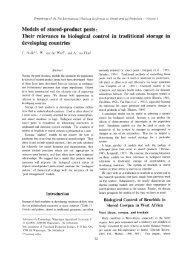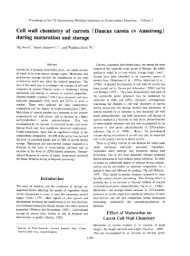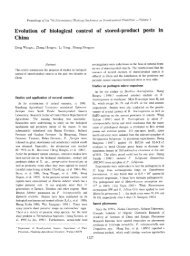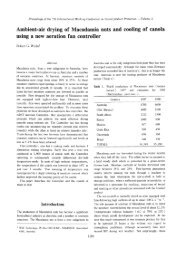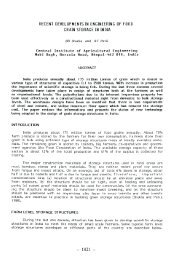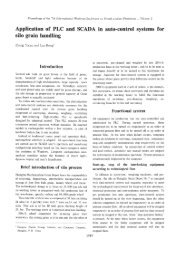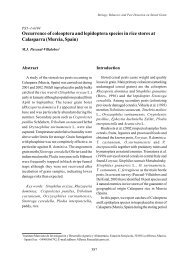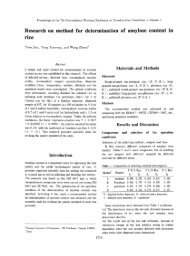Coping strategies employed by farmers against the larger grain ...
Coping strategies employed by farmers against the larger grain ...
Coping strategies employed by farmers against the larger grain ...
Create successful ePaper yourself
Turn your PDF publications into a flip-book with our unique Google optimized e-Paper software.
-<br />
~ as<br />
..s<br />
~ 30<br />
Co<br />
~ ee<br />
25<br />
.0<br />
~ 20<br />
0<br />
- 15<br />
.0<br />
"<br />
E<br />
0 10<br />
"<br />
"'"<br />
E<br />
Fig.4a.<br />
Proceedings of <strong>the</strong> 7 th International Working Conference on Stored-prcduc: Protection - Volwme 2<br />
40 -_ .._"------ ------<br />
Olocal<br />
composite<br />
Ij hybrid<br />
~<br />
.~<br />
§<br />
i2<br />
Quantity of maize sold in a normal year.<br />
Role of P. truncatus in maize harvest<br />
In three of <strong>the</strong> regions <strong>the</strong>re has been a significant<br />
reduction in <strong>the</strong> quantity of maize harvested but this change<br />
was not induced <strong>by</strong> P. truncatus; in none of <strong>the</strong> regions<br />
was production influenced <strong>by</strong> <strong>the</strong> pest (Figure 5). Most<br />
fanners interviewed said ei<strong>the</strong>r that <strong>the</strong>re had been no<br />
change in quantity of maize harvested in comparison to 15<br />
'" ...<br />
" S...<br />
100%<br />
90%<br />
80%<br />
70%<br />
..g 60%<br />
'-<br />
0<br />
'" ee<br />
50%<br />
40%<br />
c;<br />
'" s-<br />
30%<br />
'"~ 20%<br />
10%<br />
0%<br />
~<br />
"<br />
"E 10<br />
...;::<br />
-"; 8<br />
e".<br />
.c<br />
~ o<br />
.c -"<br />
Eoe.<br />
'" 2~ 2 '" '"<br />
0<br />
'"<br />
es<br />
~ f-<br />
§ 0<br />
~<br />
~<br />
OIl "i5i<br />
~<br />
~<br />
'2 co .0<br />
.:;: .s "3 oj 8<br />
"<br />
"E<br />
tjlccal<br />
composite<br />
. ~ 2<br />
l'<br />
Y ~<br />
.s<br />
E ~<br />
;:; "<br />
~ -g<br />
E '" ~<br />
~<br />
Fig.4b. Quantity of maize sold in a drought year.<br />
years ago (Arusha , Kilimanjaro, Tabora) or tbat harvest<br />
had reduced but this had been due to factors o<strong>the</strong>r than LGB<br />
( Morogoro, Rukwa ) . In Iringa , <strong>the</strong> picture was more<br />
complicated with roughly 40% of <strong>farmers</strong> saying that <strong>the</strong>re<br />
had been no change, 30% saying that <strong>the</strong>re had been a<br />
decrease (not due to LGB) and <strong>the</strong> remainder stating that<br />
<strong>the</strong>re had been an increase.<br />
"<br />
Unstated<br />
o Increase unstated reason<br />
CJ Increase from fertilizers<br />
znncrease from HYV<br />
m Decrease for o<strong>the</strong>r reasons<br />
m Decrease because of LGB<br />
ONe change<br />
Fig.5. Reasons for <strong>the</strong> changes in <strong>the</strong> quantity of maize harvested at present in comparisonwith 15 years ago.<br />
Role of P. truncatus in maize varieties<br />
organisation. New varieties, particularly hybrids, have been<br />
developed for <strong>the</strong> high potential areas and so are used in<br />
The majority of <strong>farmers</strong> are currently cultivating <strong>the</strong> same districts in Iringa and Morogoro, HYVs are more susceptible<br />
varieties now as <strong>the</strong>y were 15 years ago (Figure 6). Those to insects, including P. t.runcaius during storage, but this<br />
<strong>farmers</strong>, who are using different varieties, especially in has not induced <strong>farmers</strong> to change varieties except in<br />
Morogoro, are doing so because improved varieties have<br />
Kilimanjaro.<br />
become available. There are now many international seed Role of P. truncatus in duration of storage and<br />
companies developing and distributing maize seed in volume of sales at fann level<br />
Tanzania, whereas before 1990 seed was only available<br />
through <strong>the</strong> Tanzanian Seed Company, a parastatal<br />
1776<br />
Figure 7a, 7b and 7c indicates <strong>the</strong> length of time after




